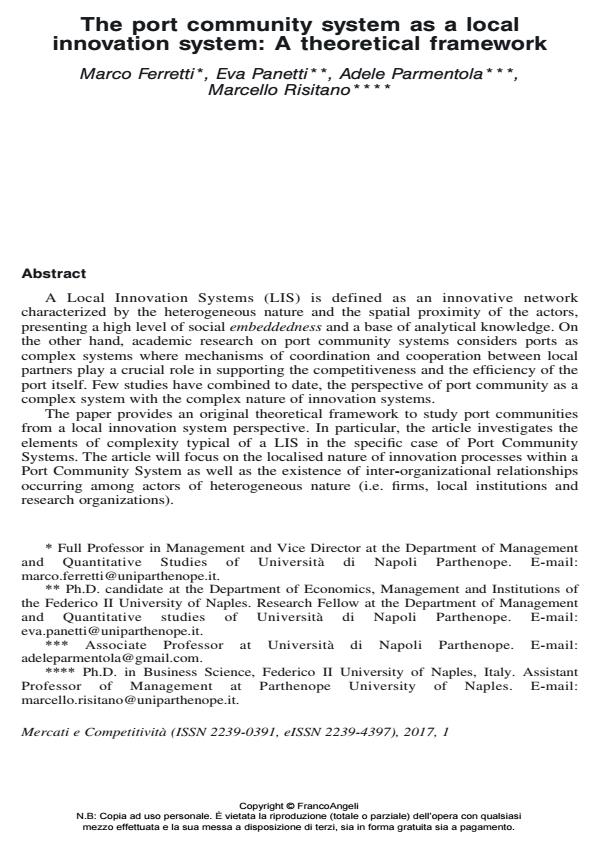The port community system as a local innovation system: A theoretical framework
Journal title MERCATI & COMPETITIVITÀ
Author/s Marco Ferretti, Eva Panetti, Adele Parmentola, Marcello Risitano
Publishing Year 2017 Issue 2017/1
Language English Pages 22 P. 97-118 File size 133 KB
DOI 10.3280/MC2017-001006
DOI is like a bar code for intellectual property: to have more infomation
click here
Below, you can see the article first page
If you want to buy this article in PDF format, you can do it, following the instructions to buy download credits

FrancoAngeli is member of Publishers International Linking Association, Inc (PILA), a not-for-profit association which run the CrossRef service enabling links to and from online scholarly content.
A Local Innovation Systems (LIS) is defined as an innovative network characterized by the heterogeneous nature and the spatial proximity of the actors, presenting a high level of social embeddedness and a base of analytical knowledge. On the other hand, academic research on port community systems considers ports as complex systems where mechanisms of coordination and cooperation between local partners play a crucial role in supporting the competitiveness and the efficiency of the port itself. Few studies have combined to date, the perspective of port community as a complex system with the complex nature of innovation systems. The paper provides an original theoretical framework to study port communities from a local innovation system perspective. In particular, the article investigates the elements of complexity typical of a LIS in the specific case of Port Community Systems. The article will focus on the localised nature of innovation processes within a Port Community System as well as the existence of inter-organizational relationships occurring among actors of heterogeneous nature (i.e. firms, local institutions and research organizations). These relationships will be analysed according to the innovative value of the economic externalities they are able to produce and according to their ability to confer economic value to the results of academic research.
Keywords: Local innovation systems, triple helix, port community, port competitiveness, port of Rotterdam, spatial proximity
- The port authority as system builder in cross-border regionalization: An exploratory study of port Esbjerg in the development of north sea wind Henrik Sornn-Friese, Petar Sofev, Kirils Kondratenko, in Maritime Transport Research 100084/2023 pp.100084
DOI: 10.1016/j.martra.2023.100084 - Computational Science and Its Applications – ICCSA 2025 Workshops Irina Di Ruocco, Marco Mazzarino, pp.125 (ISBN:978-3-031-97647-6)
Marco Ferretti, Eva Panetti, Adele Parmentola, Marcello Risitano, The port community system as a local innovation system: A theoretical framework in "MERCATI & COMPETITIVITÀ" 1/2017, pp 97-118, DOI: 10.3280/MC2017-001006